Sources for Ulrainian bombs during the fighting for independence in 1918-1920 are really scarce, and most are posterior to the event and have a neat tendency to me more ideological driven that historical. Thess sources present the following picture:
1) The main source of replenishment of the aviation fleet of the flying department was the former German warehouse in Proskurov (now the city of Khmelnytskyi), where the equipment left after the withdrawal of German troops from the territories of Ukraine was concentrated.
2) Galicians, thanks to their efficient work, obtained bombs from different countries and different designs from the Austrian, German and Russian armies that were returning to their native lands.. At first there were no more than a hundred of them: 50-pounders, Russian-made, etc.
3) Since there were not enough aircraft bombs, the artillery workshop in Kolomyia set up a conversion of mortar ammunition into aircraft bombs.
4) In addition to high-explosive and composite bombs, there were no more than 70 incendiary bombs. Soon, a replenishment of air bombs came from Kolomyia. Here they began to convert mines and grenades into bombs . According to I. Fostakovsky, these bombs often did not explode, so their combat value was insignificant
The only photograph I could find among Ukrainian sources is this one taken in Lviv in 1919 - a highly interesting one but also a somewaht problematic one:
The same photograph is present in Polish historical sources under the legend : Pilots of the 6th squadron in Lvov 1919
In fact in 1918 in Austrian Lemberg which population was mainly Polish becvame the Polish Lvov. There was an Ukrainian attempt in November 1918 to seize the city, but after 3 weeks Lvov was once again in Polish hands, the ukrainian maintaining a siege aorund the city till April 1919.
Whatever...this photographic document is highly interesting: The bombs, with one notable exception, are of Austro-Hungarian origin (including the German made PuW which were standard equipment in the Austro Hungarian aviation) .
We have from Right to left Rear Row:
50kg Traisen-Nacheilbomb, 25kg Traisen-Nacheilbomb, "Unidentfied" (I am deeply unsure about this one -a 25kg order bomb, it appears in other Polish photographs but the tail is never clearly seen, however it does not seeems to be a PuW) , 12.5 PuW Frag, 10kg Incendiary PuW
and on the ground from Right to Left in the Front Row:
50kg Carbonit, 20kg Carbonit, 25kg Traisen-Voreilbombe, and on the extreme left the most interesting projectile in this photograph - a locally madw bomb on the basis of the shell of the 58mm FR mortar (FR = Franco-Russian, an adaptation by Russian Captain Likhonin of the Mortier de 58 mm de tranchée Modèle No. 2 systeme Dumezil) - Three different version of the 58mm FR shell existed, this is the welded version.
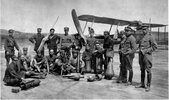
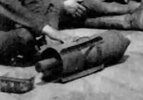
Here are photographs of teh Likhonin modified 59mm "F.R." mortar and its projectile (in different variations)
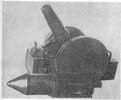
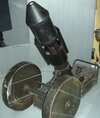
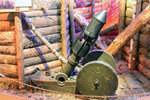
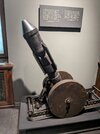
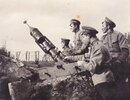
And as a bonus another photograph from Kiev 1919 from a Polish source (amnd the uniforms have a distinctive Polish look with the confederatka cap on the head of the officer on teh right), this time with an Oranovsky bomb of Russian origin:
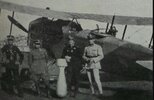
1) The main source of replenishment of the aviation fleet of the flying department was the former German warehouse in Proskurov (now the city of Khmelnytskyi), where the equipment left after the withdrawal of German troops from the territories of Ukraine was concentrated.
2) Galicians, thanks to their efficient work, obtained bombs from different countries and different designs from the Austrian, German and Russian armies that were returning to their native lands.. At first there were no more than a hundred of them: 50-pounders, Russian-made, etc.
3) Since there were not enough aircraft bombs, the artillery workshop in Kolomyia set up a conversion of mortar ammunition into aircraft bombs.
4) In addition to high-explosive and composite bombs, there were no more than 70 incendiary bombs. Soon, a replenishment of air bombs came from Kolomyia. Here they began to convert mines and grenades into bombs . According to I. Fostakovsky, these bombs often did not explode, so their combat value was insignificant
The only photograph I could find among Ukrainian sources is this one taken in Lviv in 1919 - a highly interesting one but also a somewaht problematic one:
The same photograph is present in Polish historical sources under the legend : Pilots of the 6th squadron in Lvov 1919
In fact in 1918 in Austrian Lemberg which population was mainly Polish becvame the Polish Lvov. There was an Ukrainian attempt in November 1918 to seize the city, but after 3 weeks Lvov was once again in Polish hands, the ukrainian maintaining a siege aorund the city till April 1919.
Whatever...this photographic document is highly interesting: The bombs, with one notable exception, are of Austro-Hungarian origin (including the German made PuW which were standard equipment in the Austro Hungarian aviation) .
We have from Right to left Rear Row:
50kg Traisen-Nacheilbomb, 25kg Traisen-Nacheilbomb, "Unidentfied" (I am deeply unsure about this one -a 25kg order bomb, it appears in other Polish photographs but the tail is never clearly seen, however it does not seeems to be a PuW) , 12.5 PuW Frag, 10kg Incendiary PuW
and on the ground from Right to Left in the Front Row:
50kg Carbonit, 20kg Carbonit, 25kg Traisen-Voreilbombe, and on the extreme left the most interesting projectile in this photograph - a locally madw bomb on the basis of the shell of the 58mm FR mortar (FR = Franco-Russian, an adaptation by Russian Captain Likhonin of the Mortier de 58 mm de tranchée Modèle No. 2 systeme Dumezil) - Three different version of the 58mm FR shell existed, this is the welded version.


Here are photographs of teh Likhonin modified 59mm "F.R." mortar and its projectile (in different variations)





And as a bonus another photograph from Kiev 1919 from a Polish source (amnd the uniforms have a distinctive Polish look with the confederatka cap on the head of the officer on teh right), this time with an Oranovsky bomb of Russian origin:

Last edited:
